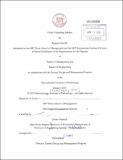| dc.contributor.advisor | Stuart Madnick. | en_US |
| dc.contributor.author | Gorelik, Eugene | en_US |
| dc.contributor.other | Massachusetts Institute of Technology. Engineering Systems Division. | en_US |
| dc.date.accessioned | 2013-08-08T17:53:06Z | |
| dc.date.available | 2013-08-08T17:53:06Z | |
| dc.date.copyright | 2013 | en_US |
| dc.date.issued | 2013 | en_US |
| dc.identifier.uri | http://hdl.handle.net/1721.1/79811 | |
| dc.description | Thesis (S.M. in Engineering and Management)--Massachusetts Institute of Technology, Engineering Systems Division, 2013. | en_US |
| dc.description | Cataloged from PDF version of thesis. | en_US |
| dc.description | Includes bibliographical references (p. 79-80). | en_US |
| dc.description.abstract | Information Technology has always been considered a major pain point of enterprise organizations, from the perspectives of both cost and management. However, the information technology industry has experienced a dramatic shift in the past decade - factors such as hardware commoditization, open-source software, virtualization, workforce globalization, and agile IT processes have supported the development of new technology and business models. Cloud computing now offers organizations more choices regarding how to run infrastructures, save costs, and delegate liabilities to third-party providers. It has become an integral part of technology and business models, and has forced businesses to adapt to new technology strategies. Accordingly, the demand for cloud computing has forced the development of new market offerings, representing various cloud service and delivery models. These models significantly expand the range of available options, and task organizations with dilemmas over which cloud computing model to employ. This thesis poses analysis of available cloud computing models and potential future cloud computing trends. Comparative analysis includes cloud services delivery (SaaS, PaaS, IaaS) and deployment models (private, public, and hybrid). Cloud computing paradigms are discussed in the context of technical, business, and human factors, analyzing how business and technology strategy could be impacted by the following aspects of cloud computing: --Architecture --Security --Costs --Hardware/software trends (commodity vs. brands, open vs. closed-source) --Organizational/human Factors To provide a systematic approach to the research presented in this paper, cloud taxonomy is introduced to classify and compare the available cloud service offerings. In particular, this thesis focuses on the services of a few major cloud providers. Amazon Web Services (AWS) will be used as a base in many examples because this cloud provider represents approximately 70% of the current public cloud services market. Amazon's AWS has become a cloud services trend-setter, and a reference point for other cloud service providers. The analysis of cloud computing models has shown that public cloud deployment model is likely to stay dominant and keep expanding further. Private and Hybrid deployment models are going to stay for years ahead but their market share is going to continuously drop. In the long-term private and Hybrid cloud models most probably will be used only for specific business cases. IaaS service delivery model is likely to keep losing market share to PaaS and SaaS models because companies realize more value and resource-savings from software and platform services rather than infrastructure. In the near future we can expect significant number of market consolidations with few large players retaining market control at the end. | en_US |
| dc.description.statementofresponsibility | by Eugene Gorelik. | en_US |
| dc.format.extent | 80 p. | en_US |
| dc.language.iso | eng | en_US |
| dc.publisher | Massachusetts Institute of Technology | en_US |
| dc.rights | M.I.T. theses are protected by
copyright. They may be viewed from this source for any purpose, but
reproduction or distribution in any format is prohibited without written
permission. See provided URL for inquiries about permission. | en_US |
| dc.rights.uri | http://dspace.mit.edu/handle/1721.1/7582 | en_US |
| dc.subject | Engineering Systems Division. | en_US |
| dc.title | Cloud computing models | en_US |
| dc.type | Thesis | en_US |
| dc.description.degree | S.M.in Engineering and Management | en_US |
| dc.contributor.department | Massachusetts Institute of Technology. Engineering Systems Division | |
| dc.identifier.oclc | 850420302 | en_US |
